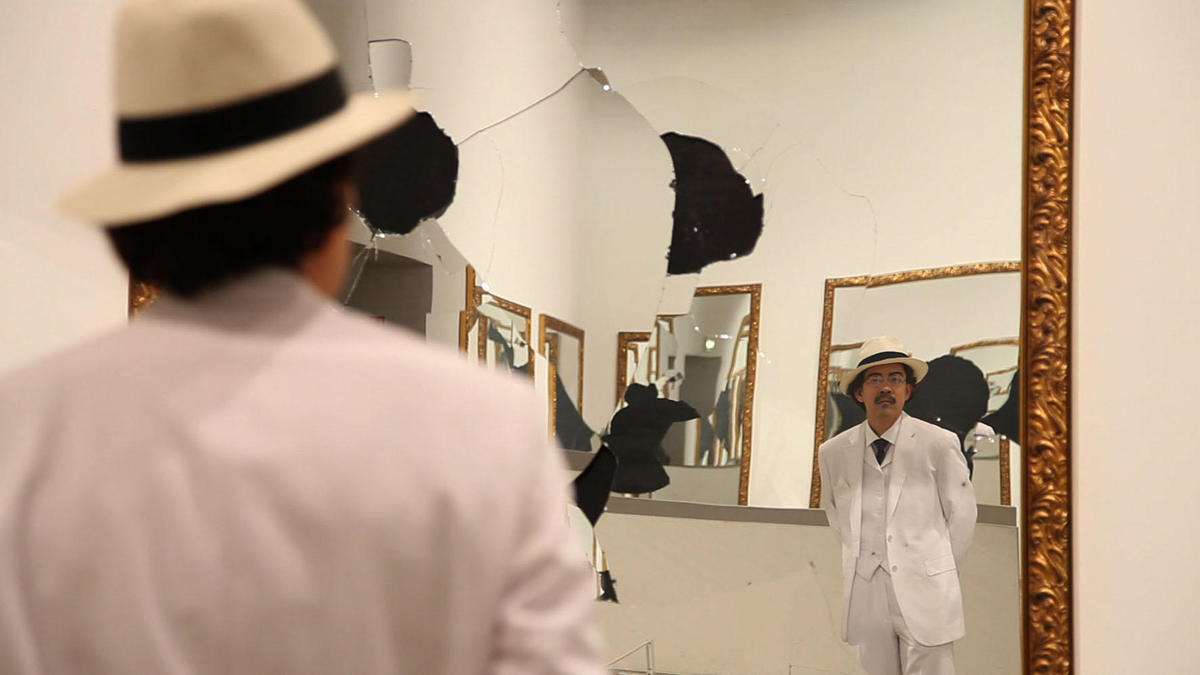Deutsch mit Arabisch nicht gut.
“Germans with Arabs not good.”
Warum?
“Why?”
Weis Nicht. Deutsch mit Arabisch nicht gleiche Mensch.
“Don’t know. Germans and Arabs are not the same people.”

The German-English dialogue above appears as doubled subtitles for a tense exchange between a German woman and a Moroccan man on a dance floor — a not entirely unlikely scenario, except for the fact that a Chinese man plays both characters.
The scene is just a snippet from Ming Wong’s Angst Essen/Eat Fear (2008), a mad re-imagining of Rainer Werner Fassbinder’s Angst Essen Seele auf (Fear Eats the Soul), itself a searing love story about a Moroccan guest worker and a much older German cleaning lady. In his 1974 film, Fassbinder lingers on the couple’s ethnic difference as the primary cause of their social persecution (they are heckled by just about everyone, and the Arab gets a stomach ulcer). Wong’s twenty-seven-minute re-rendering, shot and shown in the immigrant-dense quarter of Kreuzberg, ought to have had resonance in Germany, where national debates about the assimilation of foreigners are ongoing. Yet it offers up a great deal more than a simple commentary on multiculturalism and its discontents.
A Chinese expatriate raised in Singapore, educated in the United Kingdom, and now a resident of Berlin, Wong has tugged at his own itinerancy in crafting a distinct body of work over the last decade. The status of being a perpetual outsider has both animated and structured his mostly self-directed, mostly hilarious videos. In his staged re-interpretations of canonical films, Wong plays just about every role.
Slipping in and out of a host of characters, he indulges in the ambivalence of a polymorphous entity and also answers to the postmodern, metropolitan myth of that entity having being liberated from any sort of belonging. Whether it is Wong himself embodying sixteen characters in a work inspired by Malay showbiz icon P Ramlee, a Muslim who made over sixty movies from the 1950s to 1970s in Singapore and Malaysia, or a version of Douglas Sirk’s Imitation of Life (1959) in which three male actors from the three different ethnic groups (Chinese, Malay, and Indian) in Singapore take turns playing the black mother and her “white” daughter, something in these reenactments is always a bit off. Accent, nationality, appearance, and gender are all scrambled up in one fine mess, and in the end, the shoes, as it were, don’t always fit. If Anthony Appiah envisaged (and celebrated) a new form of cosmopolitanism in his book by the same title, Wong lays bare a more subtle understanding of the mobile and adaptive realities of identity in a globalized world. Identity does exist, after all! And it matters, too.
In keeping with his previous work, Wong’s latest Life and Death in Venice (2009) and Devo Partire Domani/I Must Go Tomorrow (2010) further his mediation of place as an outsider through the prism of fictional film worlds. Yet for the first time, Wong filmed on location. By having formerly located all of his works indoors, he had somehow accorded himself the comfort of a knowing critical distance. The homemade costumes, wigs, staged studio sets, and DIY digital montages had served to fortify and emphasize his position as a remote-auteur.
All of that changed with Life and Death in Venice, a three-channel installation in which the aging composer character Aschenbach and the adolescent Tadzi wander through real-life Venice on opposite screens. Wong awkwardly plays both roles and, of course, looks too young for the former and too old for the latter. A moment of organized synchronicity has them exchange glances, and we, along with Wong, are caught between youth and old age. As they stroll, the pair pass through the fifty-third Venice Biennale and the Grand Hotel de Bains, in which the original film was shot (as it happens, shortly after Wong’s production, it was closed down to be converted into a luxury apartment complex). Filmed in these extremely coded locations, the piece exists as a layered archive of place, not to mention a stirring ode to mortality and transience.
In his newest Devo Partire Domani/I Must Go Tomorrow, which is based on Pier Paolo Pasolini’s Teorema (1968), Wong supplants the studio for real-life Naples. Each member of the bourgeois Italian family of the original film — Wong plays all of them — is seduced by the mysterious stranger, also played by Wong. In collective despair, they find themselves staggering through the Bagnoli industrial wasteland, the Scampia housing projects, and the eighteenth-century Villa San Genariello. The reenactment takes on added resonance when one begins to think about the fact that Pasolini, too, was an itinerant filmmaker.

Yet in Naples, Wong does not relegate landmarks to their potential fates as static backdrops and settings, empty vessels onto which a number of significations could be projected. Instead, he crafts a more ambiguous relationship to the architecture, responding to a specific history of Italian mise-en-scène that has been rehearsed before (Michelangelo Antonioni and his acclaimed tetralogy immediately come to mind). Here, urban space is treated dialectically, not simply as a trope to expose binary oppositions or highlight alienated social states. The landscape and all its various components are recognized as having histories of their own, which are also changing and adapting like the various Wongs staggering through them.
The stranger in Pasolini’s Teorema has sexual encounters with every member of the family, and after he vanishes, each character descends into madness, promiscuity, or some form of catatonia. It is around these various conditions of unraveling that Wong constructs his five-channel installation, occupying five rooms with each screen devoted to a different character. The sonic bleed between the different rooms continues to place the characters in communal correlation to one another, while on screen they are woven into the social fabric of contemporary Naples. Wong’s re-imaging and embodiment of the characters is suffused with empathy, guiding each to a conclusion that seeks to bear out their own agency in their own evolving realities. In the end, Wong has seduced himself, confessed to himself, slept with himself, prostituted himself, and finally, abandoned himself. In doing so, he unmasks an agency that anyone, not only the artist, has to re-imagine while transcending inherited ideas about self, and in the process, acknowledging one’s own curious “becoming.”